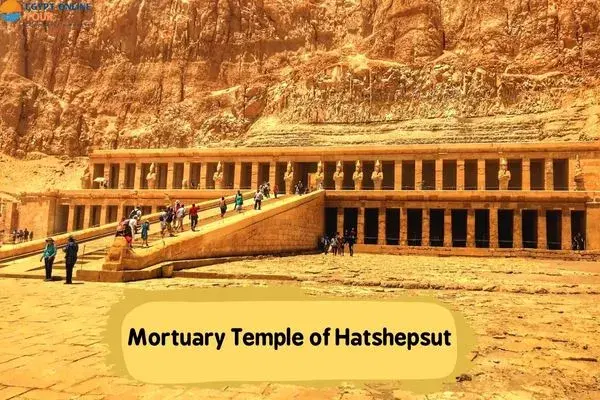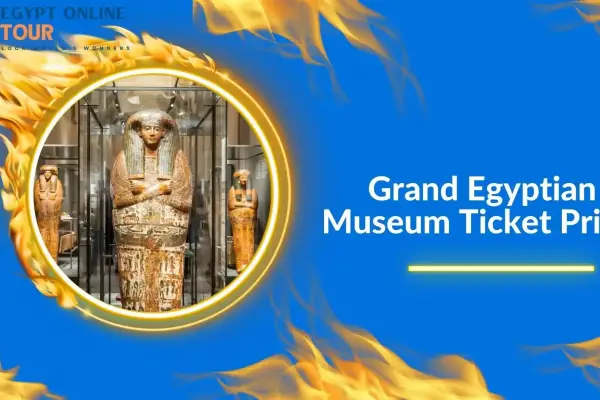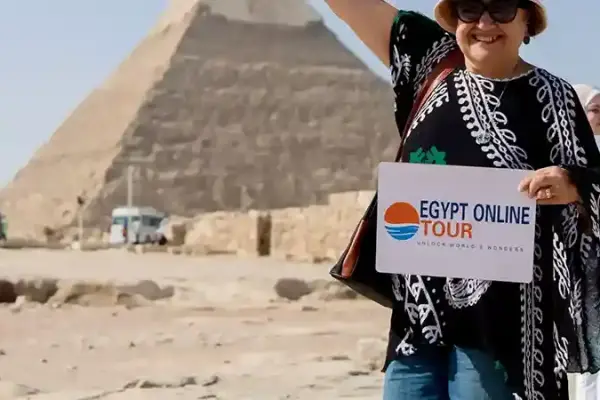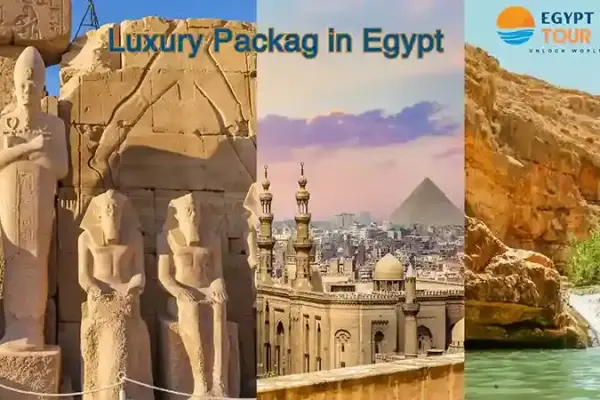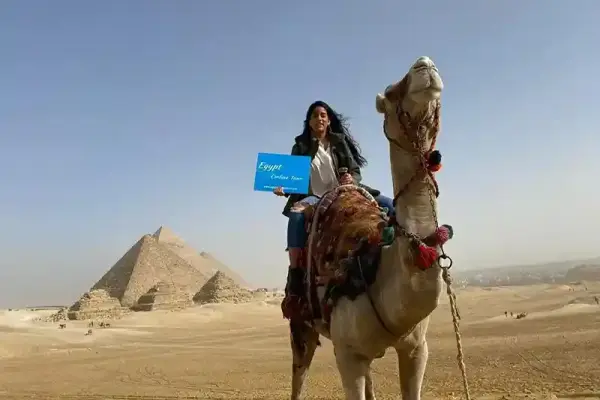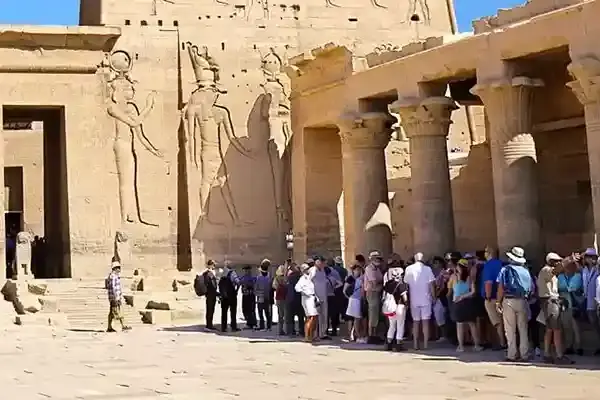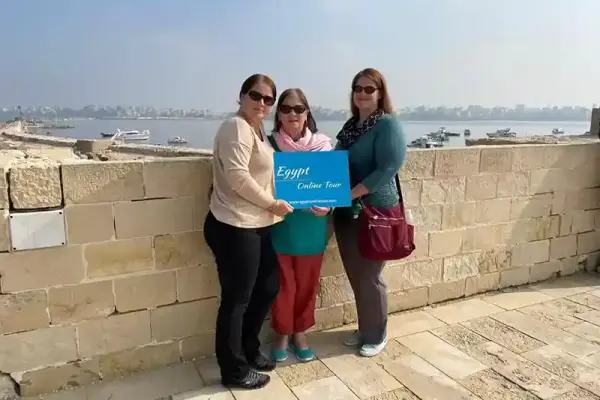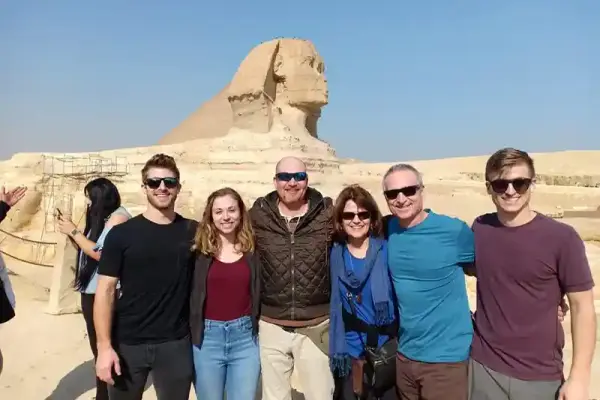The Mortuary Temple of Hatshepsut is among Luxor’s most celebrated sites, yet what sets it apart? Cut into the cliffs of Deir el-Bahari, it reflects the ambition of Egypt’s renowned female pharaoh. Its terraces, ramps, and carvings display scenes of divine birth, successful trade journeys, and devotion to the gods. Why does it still capture admiration after thousands of years? Discover its history, mysteries, and enduring beauty that continue to fascinate visitors worldwide.
Table of contents [Show]
- Mortuary Temple of Hatshepsut History: A Queen’s Legacy in Stone
-
Mortuary Temple of Hatshepsut Facts: History, Design, and Legacy
-
11 Brief Facts About the Mortuary Temple of Hatshepsut
- 1. Built by Egypt’s great female pharaoh
- 2. Designed by Senenmut
- 3. Carved into cliffs
- 4. Three grand terraces
- 5. Dedicated to the gods
- 6. Political and religious symbol
- 7. Punt Expedition reliefs
- 8. Erased by Thutmose III
- 9. Later turned into a monastery
- 10. Rediscovered and excavated
- 11. UNESCO World Heritage Site
-
11 Brief Facts About the Mortuary Temple of Hatshepsut
- Deeper Insights into the Temple
- History of the Mortuary Temple of Hatshepsut
- A Timeless Marvel of Stone: Architecture and Design of the Temple of Hatshepsut
- Mortuary Temple of Hatshepsut: Three Terraces and Grand Ramps
- The Punt Expedition Reliefs: Trade, Wealth, and Divine Legacy
- The Divine Birth Scenes of Hatshepsut: A Queen’s Claim to Divine Rule
- Sanctuary of Amun and Inner Chapels: Sacred Core, Clear Design, Lasting Message
- Functions and Messages Inside the Inner Core
- Facts About Hathor Chapel and Anubis Shrine You Must Know
- Osiride Statues of Hatshepsut: Symbols of Eternal Power
- Key Details of the Osiride Statues
- What Do 6 Key Facts Reveal About The Valley Temple and Causeway?
- Role of Senenmut in the Temple’s Construction
- Restoration and Archaeological Discoveries at the Mortuary Temple of Hatshepsut
- Best Time to Visit the Mortuary Temple of Hatshepsut
- How to Get to Deir el-Bahari from Luxor
- Visitor Tips for Exploring the Temple
- Summary
Mortuary Temple of Hatshepsut History: A Queen’s Legacy in Stone
The Mortuary Temple of Hatshepsut is one of Egypt’s most extraordinary monuments. Built against the cliffs of Deir el-Bahari near Luxor, it reflects power, devotion, and innovation. I will explore the history, design, meaning, and revival of the Mortuary Temple of Hatshepsut through time.
Origins and Construction
- Commissioned by Queen Hatshepsut, one of Egypt’s most successful rulers.
- Built during the 18th Dynasty, around 1479–1458 BCE.
- Architect Senenmut designed the terraces and long ramps.
- Construction lasted almost 15 years.
- Carved directly into limestone cliffs to blend with the natural setting.
Purpose and Function
- Served as Hatshepsut’s funerary temple.
- Dedicated to Amun, the sun god, Hathor, Anubis, and other deities.
- Housed chapels, sanctuaries, and offering halls.
- Used for offerings, rituals, and royal festivals.
- Celebrated Hatshepsut’s divine birth and role as pharaoh.
- Reinforced her claim to power in a male-dominated world.
Architectural and Artistic Features
- Three rising terraces connected by processional ramps.
- Colonnades decorated with carved reliefs and painted walls.
- Scenes showed her divine birth and trading expeditions.
- Statues depicted her as both a king and a woman.
- Chapels dedicated to gods ensured spiritual balance.
- Walls displayed daily life, agriculture, and military victories.
- Blend of symmetry, balance, and natural setting.
Key Historical Highlights
- Reliefs show the Punt Expedition, recording exotic trade goods.
- Walls also show military victories, daily life, and agriculture.
- After Hatshepsut’s death, Thutmose III defaced her images.
- Despite this erasure, much of the temple’s art survived.
- Later converted into a Christian monastery, giving it the name Deir el-Bahari.
Religious Role
- Celebrated the Festival of the Valley, honoring Amun.
- Linked with Karnak Temple across the Nile through ritual processions.
- Connected the mortal realm with the divine world.
- Priests conducted offerings, chants, and sacred rites.
Rediscovery and Preservation
- Forgotten for centuries under sand and rockfalls.
- Rediscovered in the 18th century by European travelers.
- Excavations began in the 19th century by Egyptologists.
- Modern work by the Polish Academy restored statues and reliefs.
- Preservation continues to protect reliefs from erosion and tourism.
- Today, it stands as a UNESCO World Heritage site.
Key Facts About the Mortuary Temple of Hatshepsut
Feature | Details |
Location | Deir el-Bahari, Luxor (West Bank of the Nile) |
Dynasty | 18th Dynasty, reign of Queen Hatshepsut |
Architect | Senenmut, her trusted advisor |
Main Purpose | Funerary temple and ritual center |
Structure | Three terraces, ramps, and colonnades |
Famous Reliefs | Punt Expedition, the divine birth of Hatshepsut |
Religious Role | Rituals for Amun, Hathor, Anubis, and afterlife offerings |
Later Use | Converted into a Christian monastery (Deir el-Bahari) |
Modern Preservation | Preservation Status Restored and partially reconstructed, UNESCO World Heritage Site |
Legacy of the Temple
- Marks a new stage in Egyptian temple architecture.
- Proves the authority of a female pharaoh.
- Inspired later kings in their temple designs.
- Still studied by scholars and admired by visitors.
- Remains a symbol of strength, vision, and endurance.
Timeline of the Mortuary Temple of Hatshepsut
Period | Dates | Key Events and Facts |
New Kingdom | 1478–1458 BC | Hatshepsut reigns and orders the temple's construction. Guided by Senenmut, her loyal advisor, the temple rose over a period of 15 years, showcasing dedication and vision. |
New Kingdom | c. 1438 BC | Thutmose III orders the defacement and destruction of Hatshepsut’s monuments and statues. This act attempts to erase her from history. |
Coptic Period | Late 5th–8th century | The temple is converted into a Coptic monastery. Consequently, it earns the name Deir el-Bahri. |
Modern Era | Mid-19th century | Serious archaeological excavations begin at the site. Auguste Mariette leads early research. |
Modern Era | Early 20th century | The Metropolitan Museum of Art and Herbert Winlock led large-scale excavations and restoration efforts. |
Modern Era | Since 1961 | The Polish National Academy of Sciences begins major research and reconstruction of the temple. |
Final Reflection
The Mortuary Temple of Hatshepsut is more than stone terraces and reliefs. It tells the story of a queen who ruled with vision, faced erasure, yet left a lasting mark on Egypt. The temple’s survival through destruction, change, and restoration makes it a timeless reminder of human ambition and devotion. See also: How to Plan a Family Vacation in Egypt from USA?
Mortuary Temple of Hatshepsut Facts: History, Design, and Legacy
The Mortuary Temple of Hatshepsut isn't just stone; it's a story. It tells the story of a woman who became pharaoh in spite of custom. Furthermore, it showcases architectural genius that has stunned the world for over 3,000 years. Consequently, let's explore the facts that make this monument so unforgettable.
11 Brief Facts About the Mortuary Temple of Hatshepsut
It still draws visitors, historians, and archaeologists. Eleven crucial facts that demonstrate its enduring significance are listed below.
1. Built by Egypt’s great female pharaoh
- Queen Hatshepsut was history's first great female pharaoh. She didn't just reign; she transformed Egypt.
- In order to preserve her legacy, she also commissioned this temple.
- It was more than a temple—it was a statement of power, devotion, and artistry.
- Therefore, it stands as a powerful symbol of her unprecedented rule.
- The temple's design was inspired by an older one nearby, built by Mentuhotep II.
- However, Hatshepsut's vision was far grander. It was a bold statement meant to surpass all that came before.
- A Story in Stone: The temple walls are like a massive history book. They depict Hatshepsut's divine birth, claiming Amun as her true father. Additionally, they show her famous expedition to Punt, a land of riches.
2. Designed by Senenmut
- Hatshepsut's trusted advisor, Senenmut, was the architectural genius.
- Her trusted architect, Senenmut, created the terraces and aligned the structure with Karnak Temple across the Nile.
- He designed the entire complex. Interestingly, he may have been more than just her advisor; some believe he was her confidant
3. Carved into cliffs
- The temple was built at Deir el-Bahari, blending naturally with the limestone cliffs of Luxor’s west bank.
- Its three elegant terraces seem to grow from the rock itself.
- A beautiful visual conversation between human skill and nature is produced by this design.
- Original gardens and pools once framed the lower terrace.
- synchronized with the sunrise of the winter solstice for symbolic significance.
- Inspired by Mentuhotep II’s temple nearby, yet larger and more refined.
- The base stretched almost 270 feet across.
4. Three grand terraces
- It features three rising terraces connected by ramps, once surrounded by gardens and pools.
- From the bottom of the desert to the temple, three terraces progressively ascend.
- Long ramps connect the terraces in a processional style.
- Colonnades line each level, decorated with detailed reliefs.
5. Dedicated to the gods
- Though built for Hatshepsut, the temple honored Amun-Ra, Hathor, Anubis, and Ra-Horakhty.
6. Political and religious symbol
- It was both a funerary temple for rituals and a public declaration of her royal power.
7. Punt Expedition reliefs
- One of the temple's most famous reliefs details a trade mission to Punt.
- This expedition brought back incredible wealth: ivory, ebony, gold, leopard skins, and living myrrh trees
8. Erased by Thutmose III
- After her death, her stepson, Thutmose III, tried to remove her memory by defacing statues, inscriptions, and chiseling her name from walls.
- Thankfully, he failed. Her story survived, waiting to be rediscovered
9. Later turned into a monastery
- During the Christian era, it became a monastery, giving it the name Deir el-Bahari.
10. Rediscovered and excavated
- European travelers noted it in the 18th century, and major excavations followed in the 19th and 20th centuries.
- Modern Resurrection: Lost for centuries, the temple was rediscovered and meticulously restored.
- The Polish Academy of Sciences has led conservation efforts since 1961. Their work allows us to walk through her halls today
11. UNESCO World Heritage Site
Today, it is part of the Theban Necropolis, preserved as a UNESCO site and open to visitors worldwide
The Mortuary Temple of Hatshepsut remains a symbol of vision, endurance, and Egypt’s architectural brilliance.
Read about: Where is Memphis in Egypt?
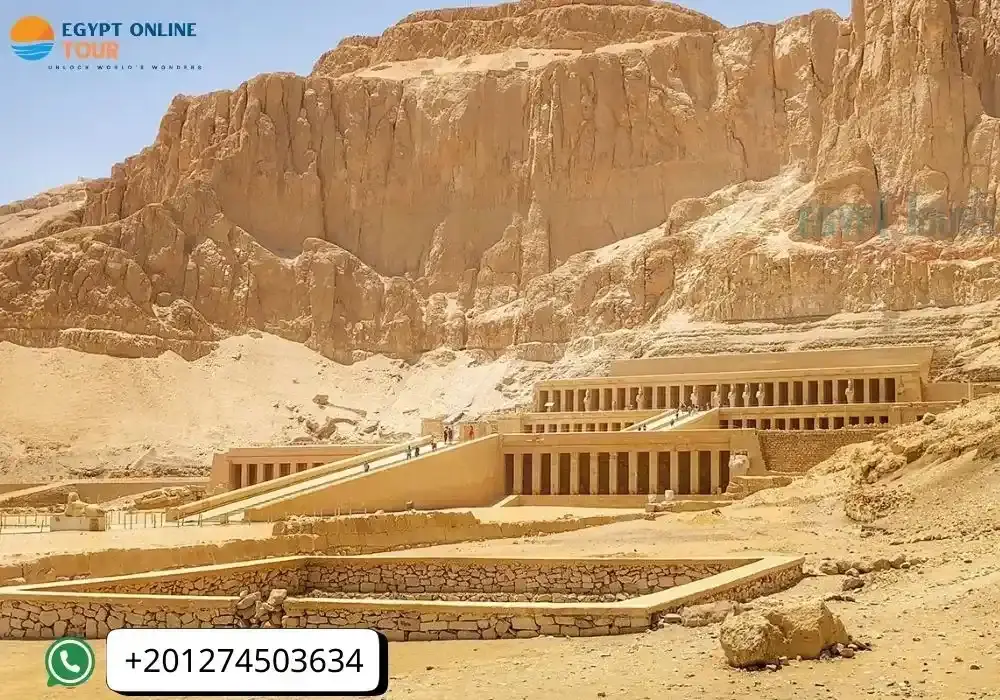
Deeper Insights into the Temple
1. More Than a Burial Place: A Political Statement
The temple was far more than a site for funerary rituals. It served as a clear display of political strength. By positioning it beside the temple of Mentuhotep II, a respected predecessor, Hatshepsut aligned herself with his glory while surpassing it with a monument of even greater scale.
2. Claiming Divine Birth
As Egypt had rarely accepted women as pharaohs, Hatshepsut needed a divine link. The reliefs in the “Birth Colonnade” depict the god Amun visiting her mother, presenting her as a daughter of a god. This narrative secured her authority as more than human, making her rule acceptable.
3. A Living Garden on the Terrace
The lowest terrace was not bare stone. It was once filled with exotic plants and shaded pools. Trees imported from Punt, known for incense and myrrh, created a sacred garden that made the site both spiritual and unique among Egyptian temples.
4. Senenmut’s Hidden Resting Place
Senenmut, the trusted architect, held unusual favor with Hatshepsut. Evidence suggests he was granted the rare honor of a tomb built within the temple grounds, an extraordinary privilege that sparked debate about the closeness of his bond with the queen.
5. Rediscovery of a Forgotten Queen
For centuries, Hatshepsut’s story lay hidden. It was not until the 19th century, when hieroglyphics were decoded, that the temple’s inscriptions revealed her achievements. This rediscovery restored her place in Egyptian history after long years of erasure.
Finally, the Mortuary Temple of Hatshepsut is more than a monument of stone. It embodies ambition, artistry, and politics, all carved into a cliffside. Despite attempts to erase her, the temple ensures that Queen Hatshepsut’s name and vision endure through time.
History of the Mortuary Temple of Hatshepsut
Imagine a monument so bold it defies both gravity and tradition. Carved into golden cliffs, the Mortuary Temple of Hatshepsut isn't just ancient history; it's a powerful story of ambition etched in stone. This guide unravels the temple's incredible journey, from its creation by a female pharaoh to its miraculous survival against all odds. Let's uncover the secrets hidden within its terraces.
A Woman Who Dared to Rule as King
Hatshepsut wasn't your average Egyptian queen. She started out as her young stepson's regent. However, she soon made an unprecedented move. She crowned herself pharaoh. To legitimize her rule, she presented herself as a male ruler in statues and art. Consequently, she commissioned monumental building projects. The campaign's focal point was her temple. It was a permanent statement of her divine right to power.
Mortuary Temple of Hatshepsut: A Queen’s Legacy Carved in Stone
The Mortuary Temple of Hatshepsut at Deir el-Bahari is an architectural masterpiece blending with the cliffs of Luxor’s west bank. Designed by Senenmut, it aligns with Karnak and the winter solstice sunrise. Its terraces display vivid reliefs of Hatshepsut’s divine birth and the Punt Expedition, showing wealth and trade. Later defaced by Thutmose III and used as a monastery, it was rediscovered and restored. It now serves as a timeless testament to tenacity, faith, and ambition.
A Legacy That Refuses to Be Forgotten
The Mortuary Temple of Hatshepsut is a profound lesson in resilience. It witnessed the rise of a revolutionary leader. It then endured a vengeful campaign to wipe it from memory. Nevertheless, it survived centuries of neglect and transformation. Today, it stands proudly as a UNESCO World Heritage site, attracting visitors from across the globe. Its resonant terraces continue to evoke wonder with their eternal tale of strength, pride, and tenacity.
See Is Egypt a popular place to visit in 2025?
Let our local travel experts help you design the perfect itinerary. Whether you're seeking adventure, culture, or relaxation, we've got you covered!
A Timeless Marvel of Stone: Architecture and Design of the Temple of Hatshepsut
On Luxor’s west bank, countless monuments reflect the grandeur of ancient Egypt. Yet, none match the elegance of the Mortuary Temple of Hatshepsut at Deir el-Bahari. It stands as one of the finest achievements of architecture blended with nature. I explore the architecture and design of Hatshepsut’s temple, its construction, symbolic meaning, and survival through history.
Engineering Genius at Deir el-Bahari
The temple was built at the base of cliffs in a bay long associated with the goddess Hathor. Hatshepsut entrusted the project to her architect and advisor, Senenmut, who designed it with precision and symbolic intent.
- Positioned along an axis that connected to Karnak Temple on the opposite bank of the Nile.
- Aligned with the sunrise of the winter solstice.
- Inspired by the earlier temple of Mentuhotep II, but far more ambitious in scale.
- Construction spanned about 15 years, from the 7th to the 22nd year of her reign.
The result was a structure that seemed to grow naturally from the cliffs yet asserted its own monumental presence.
If you want to visit Cairo, don't wait to find out more: The cost of admission to the Grand Egyptian Museum Ticket Price
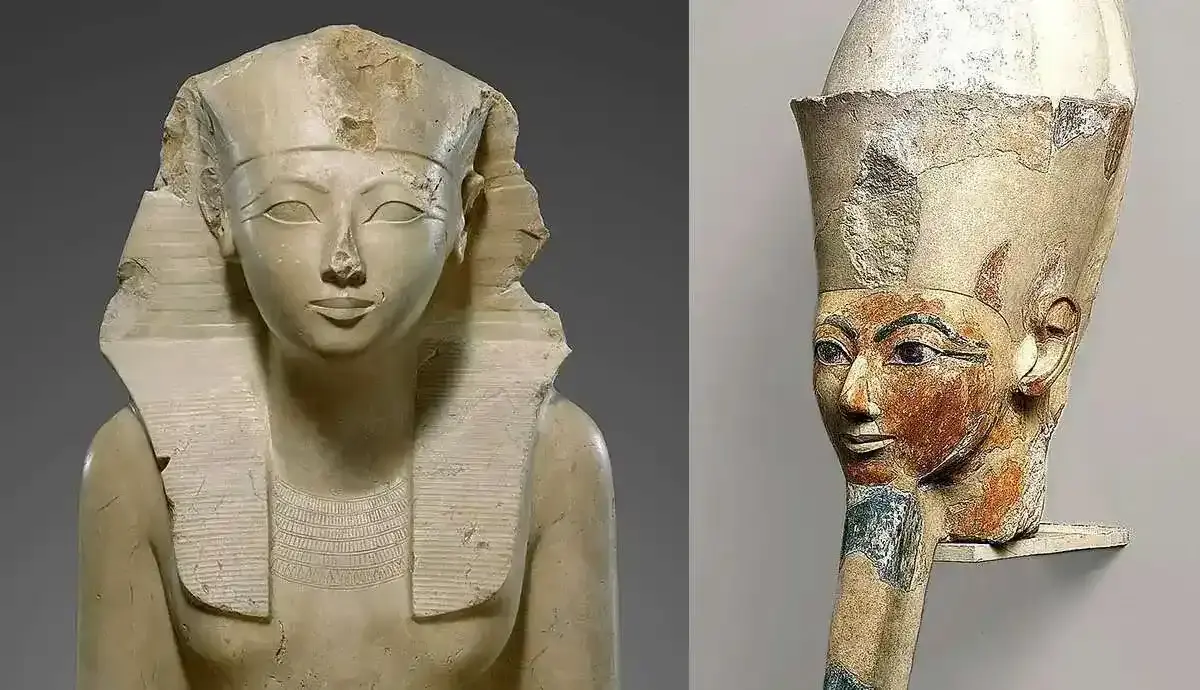
Terraces and Ramps: A Sacred Ascent
The layout is defined by three vast terraces linked by ramps, creating a processional pathway that guided visitors upward.
- Lower Terrace: Wide and deep, with colonnades of 22 columns and a single entrance gate.
- Middle Terrace: Featured reliefs and chapels, with proto-Doric columns marking its portico.
- Upper Terrace: Opened through a granite gateway into a grand festival court.
This rising sequence symbolized the queen’s elevation from the earthly realm to divine status.
Building Materials and Craftsmanship
The temple was built mostly of limestone, but other stones added strength and beauty.
- Limestone formed the terraces, porticoes, and walls.
- Red granite was used for gates and key statues.
- A rare violet sandstone architrave, possibly reused from an older temple, was included.
The modest scale of the interior rooms contrasted with the commanding exterior, showing the monument’s role as a public and political statement.
Chapels, Shrines, and Symbolism
The temple also served as a sacred complex with spaces dedicated to different gods.
- Hathor Chapel: Columns carved like sistrums, linked to the goddess of love and music.
- Anubis Chapel: Honored the god of embalming and protector of cemeteries.
- Osiride Statues: Lined the terraces, showing Hatshepsut in the form of Osiris.
- Reliefs of Horus and Punt: The queen was shown as the terrestrial falcon-god in the reliefs of Horus and Punt, which also showed her renowned trading journey to Punt.
These features reinforced her divine right to rule and celebrated the prosperity of her reign.
Erasure, Rediscovery, and Restoration
After Hatshepsut’s death, her stepson and successor, Thutmose III, tried to erase her legacy by destroying images and removing her name from inscriptions.
- Rediscovered in the 18th century by European travelers.
- Systematic excavation started in the 19th century, led by Auguste Mariette.
- Since 1961, the Polish Academy of Sciences has led major conservation and restoration efforts.
Make an appointment for your Egypt Classic Tours with Egypt Online Tour to join the narrative.
Key Architectural Elements
Feature | Description | Symbolism |
Terraces | Three rising platforms | Represented spiritual ascent |
Ramps | Broad connecting pathways | Signified movement toward the divine |
Alignment | Linked to Karnak and the solstice sun | Connection with cosmic order and Amun-Re |
Hathor Chapel | Shrine with sistrum columns | Honored Hathor, goddess of love and joy |
Anubis Chapel | Dedicated space | Associated with embalming and the afterlife |
Osiride Statues | Hatshepsut as Osiris | Eternal kingship and rebirth |
Materials | Limestone, granite, sandstone | Demonstrated wealth and durability |
Reliefs | Divine birth, Punt expedition | Legitimized rule and recorded achievements |
Enduring Legacy
The Mortuary Temple of Hatshepsut is more than an architectural wonder—it is a record of ambition, faith, and resilience.
- It symbolizes how a queen claimed legitimacy in a male-dominated world.
- Demonstrates Egypt’s architectural mastery and harmony with nature.
- It survived erasure, transformation, and centuries of decline.
Today, the temple attracts visitors worldwide. Its terraces and reliefs continue to tell the story of a woman who shaped Egypt’s history and ensured her vision would live on in stone.
For travelers planning their journey, this detailed Egypt Travel Guide offers useful tips to explore the country’s wonders more fully.
Mortuary Temple of Hatshepsut: Three Terraces and Grand Ramps
Numerous ancient antiquities can be found in Luxor's West Bank. Among them, one monument rises above the rest. It is a tribute to a remarkable queen and a wonder of ancient design. This guide explores the architectural brilliance of the Mortuary Temple of Hatshepsut. It explains the story behind its terraces, ramps, and sacred alignments. You will see how it was built, nearly erased, and finally restored. One of Egypt's most amazing accomplishments to this day is the Hatshepsut Mortuary Temple.
A Masterpiece of Ancient Engineering and Design
- Inspired by the nearby temple of Mentuhotep II, but more advanced in scale and harmony.
- Constructed on a straight axis that aligned with Karnak Temple across the Nile.
- Carefully designed so the winter solstice sunrise illuminated its inner sanctuary.
- Construction lasted from Hatshepsut’s 7th to 22nd regnal year.
- Known in ancient times as Djeser-Djeseru, meaning Holy of Holies.
The Three Terraces and Grand Ramps
- A Grand Causeway: A processional path nearly 1 kilometer long led directly to the temple. It was about 37 meters wide and served as the first approach.
- The Lower Terrace: A Welcoming Gate, Measured 120 meters deep by 75 meters wide. Enclosed by a wall with one main gate. Porticoes held 22 columns each, decorated with scenes of rituals. Two T-shaped pools contained papyrus plants and flowers. Lion statues once flanked the ramp balustrades.
- The Middle Terrace: Honoring the Gods measured 75 meters deep by 90 meters wide. Featured porticoes and proto-Doric columns. Held a chapel for Hathor, with sistrum-shaped columns. had a chapel dedicated to Anubis, the guardian of the dead. Famous reliefs depicted Hatshepsut’s divine birth and the trade mission to Punt.
- The Upper Terrace: The Sacred Sanctuary. Accessed through a granite gate opening into a festival courtyard. Surrounded by pillars, lined with Osiride statues of Hatshepsut as Osiris. Featured a falcon relief of Horus, showing the pharaoh’s divine role. The shrine of Amun received special focus, highlighting its religious importance.
- Symbolism of the Ramps: The three ramps linked the terraces in a staged ascent. This design symbolized the spiritual rise from earth toward the gods.
Key Architectural Elements of the Temple Terraces
Element | Description | Significance |
Lower Terrace | Broad terrace with 22 columns and water features. | Served as the ceremonial gateway to the complex. |
Middle Terrace | Chapels of Hathor and Anubis, Punt expedition reliefs. | Blended worship with visual propaganda of divine rule. |
Upper Terrace | Sanctuary with Osiride statues and an Amun shrine. | Marked the most sacred link to the god |
Grand Causeway | A long path from the valley floor to the temple entrance. | Guided processions and sacred rituals toward the rising terraces. |
Temple Alignment | Oriented toward Karnak and the solstice sunrise. | Linked the queen’s reign with cosmic cycles and divine order. |
A Testament to Endurance
The Mortuary Temple of Hatshepsut is not only terraces and statues, but it is the legacy of a visionary queen who defied tradition. Despite erasure, conversion, and centuries of silence, her temple survived. Today, its restored walls and terraces tell the story of faith, politics, and ambition. Visitors who climb its ramps follow the same path once taken by priests and royalty. In every way, it remains a timeless masterpiece of Egypt’s golden age. If you are planning a trip, here’s a guide on what is there to do in Luxor to make your visit more memorable.
The Punt Expedition Reliefs: Trade, Wealth, and Divine Legacy
Luxor’s West Bank is filled with ancient treasures. Yet few match the story told on the walls of the Mortuary Temple of Hatshepsut. Among its finest features are the Punt Expedition Reliefs. These carvings capture one of history’s most remarkable voyages. They show how Egypt reached beyond its borders, how trade built wealth, and how faith shaped politics.
I bring together the history, details, and meaning of these unique reliefs. It explains why they remain a key part of the Mortuary temple of Hatshepsut, and why they are still studied today.
The Story Written on Stone
- Built at Deir el-Bahari, beneath massive cliffs.
- The south wall of the middle portico shows the expedition.
- Reliefs date to around 1490 BCE, during Hatshepsut’s reign.
- They were not mere decorations. Instead, they were prayers in stone.
- The images symbolically repeated the journey, ensuring gifts for Amun-Re.
The Journey to a Faraway Land
- Five large ships are carved, with sails and oars in motion.
- They show Egyptians traveling across the Red Sea.
- The texts describe this mission as a command from Amun of Karnak.
- Punt’s leaders, Chieftain Parehu and his wife Ati, greeted the Egyptian envoy.
- The meeting appears peaceful and diplomatic, not hostile.
The Wealth of Punt
- Punt was famous for rare goods.
- Reliefs display incense, gold, ebony, ivory, and exotic animals.
- Live myrrh trees were among the most valued treasures.
- These trees were replanted in temple gardens, making the divine offerings eternal.
- Such goods were essential for rituals at Karnak.
Politics, Religion, and Power
- The expedition had deep political meaning.
- As a female pharaoh, Hatshepsut utilized the reliefs to bolster her authority.
- She portrayed herself as chosen by Amun, Egypt’s chief god.
- Instead of conquest, she built influence through trade and diplomacy.
- This approach set her apart from many rulers of her time.
A Window Into Ancient Life
- The reliefs show Puntite houses built on wooden stilts, surrounded by palm trees.
- They include depictions of King Parahu, Queen Ati, and their people.
- Exotic creatures appear: baboons, giraffes, and even a rhinoceros.
- Marine life is carefully carved, with over 30 species of fish, dolphins, squid, and lobsters.
- This accuracy suggests an artist may have joined the voyage.
Key Features of the Punt Expedition Reliefs
Scene | What the Relief Shows | Why It Matters |
The Journey | A fleet of five ships crossing the Red Sea. | Demonstrates the advanced naval skills and organization of Hatshepsut’s reign. |
The Arrival | Envoy greeted by Punt’s chief, Parehu, and his wife, Ati. | Highlights peaceful diplomacy and trade relations with foreign lands. |
The Trade | Puntites carrying gold, incense, and ebony. | Records the flow of valuable imports that enriched Egypt’s economy and rituals. |
The Return | Ships loaded with goods and live myrrh trees. | Symbolizes prosperity, wealth, and divine offerings brought back to Egypt. |
The Offering | Hatshepsut presents treasures to Amun at Karnak. | Reinforces her devotion to Amun and legitimizes her divine right to rule. |
The Mortuary Temple of Hatshepsut is more than terraces of stone. Its walls preserve a story of vision, diplomacy, and faith. The Punt Expedition Reliefs reveal how one woman reshaped Egypt’s image. She proved that wealth and legitimacy could come not through war, but through trade and devotion.
Though her name was later defaced, her reliefs survived. Today, they still tell the story of prosperity, peace, and divine blessing. The Mortuary Temple of Hatshepsut remains one of Luxor’s greatest treasures, its walls echoing the achievements of a remarkable queen. For those planning a visit, you may also enjoy reading about how long will the Luxor eclipse last , another event that adds to the city’s timeless allure.
Let our local travel experts help you design the perfect itinerary. Whether you're seeking adventure, culture, or relaxation, we've got you covered!
The Divine Birth Scenes of Hatshepsut: A Queen’s Claim to Divine Rule
The Mortuary Temple of Hatshepsut preserves one of ancient Egypt’s most striking narratives. Among its walls, the Divine Birth Scenes of Hatshepsut stand out. These carvings explain how she justified her right to rule in a society dominated by kings. Through art, ritual, and symbolism, she presented herself as the chosen daughter of the god Amun. Today, these scenes are studied for their political and religious meaning, making them one of the most famous parts of the Mortuary Temple of Hatshepsut.
Key Highlights of the Divine Birth Scenes
A God’s Visit to the Queen’s Mother
- Amun, king of the gods, is depicted in the engravings visiting Queen Ahmose.
- To make the relationship sacred, he assumes the identity of her spouse, King Thutmose I.
- Priests believed this ensured Hatshepsut’s divine origin.
Khnum Shapes the Child
- Khnum, the ram-headed creator god, appears at his potter’s wheel.
- He is shown forming Hatshepsut’s body and her ka, or soul.
- This step symbolized divine crafting, not ordinary birth.
The Goddess Hathor Protects the Birth
- Hathor, goddess of love and motherhood, plays a guiding role.
- She stands by as guardian of the child’s early years.
- Her presence stressed care, fertility, and legitimacy.
The Coronation Before Birth
- Reliefs show Hatshepsut crowned by the gods while still a child.
- This visual statement reinforced her divine right to rule Egypt.
- It helped silence critics who doubted a woman could be pharaoh.
Public Display of Legitimacy
- These reliefs were not hidden. They were carved on temple walls.
- Visitors and priests saw them during rituals and processions.
- This repeated exposure ensured the story became accepted truth.
Why the Scenes Mattered
Religious Justification
- The story tied her rule directly to Amun, Egypt’s highest god.
- This divine fatherhood gave her unquestioned spiritual authority.
Political Necessity
- Egypt had very few female rulers.
- By showing herself as divinely born, Hatshepsut countered opposition from nobles.
Cultural Influence
- The birth scenes blended myth with politics.
- They became a model for later pharaohs who needed divine backing.
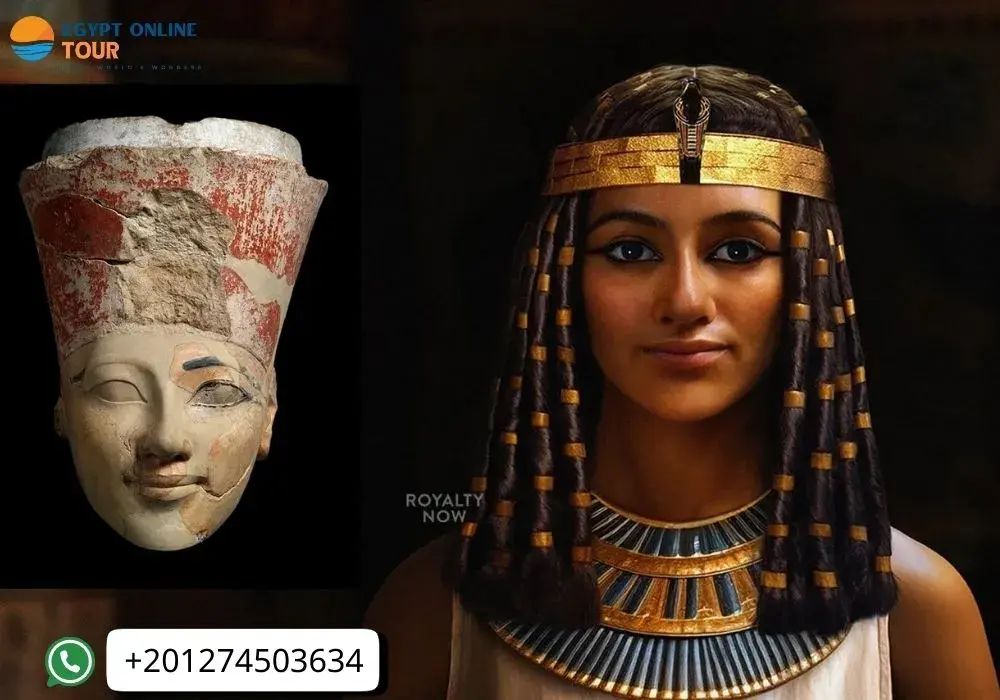
Key Elements of the Divine Birth Scenes
Element | Description | Significance |
Union of Amun & Ahmose | Amun visits Hatshepsut’s mother in kingly form. | Claims Hatshepsut as the daughter of the chief god. |
Khnum at the Wheel | Creator god fashions Hatshepsut and her soul. | Shows her birth as divine craftsmanship. |
Hathor’s Protection | Hathor assists during the birth and childhood. | Symbol of care, legitimacy, and divine motherhood. |
Child’s Coronation | Hatshepsut was crowned by the gods before adulthood. | Reinforces her rule as predestined and approved by heaven. |
Public Temple Reliefs | Scenes displayed in temple colonnades at Deir el-Bahari. | Made her divine origin visible to all worshippers. |
The Mortuary Temple of Hatshepsut is not only an architectural wonder but also a political stage. Her most convincing argument for validity was the Divine Birth reliefs. They showed her as more than a ruler—she was the chosen child of Amun, crafted by the gods, and crowned before birth. Even though later kings tried to erase her name, the scenes remain visible today. They remind visitors that history, politics, and faith were carved together in stone, securing the memory of Egypt’s most successful queen. To explore beyond Luxor, here are the 7 best attractions and activities to do in Egypt that make any trip unforgettable.
At the Mortuary Temple of Hatshepsut, faith and power meet. Here, rituals shaped memory, and art confirmed rule. Therefore, this inner zone explains the queen’s vision. Moreover, it reveals how sacred rooms guided royal legitimacy.
Central Holy Focus
- The main sanctuary sat deep within the cliff.
- Priests offered daily rites to Amun-Re.
- Consequently, the queen’s devotion appeared constant.
- Incense, hymns, and food offerings marked each service.
- Thus, divine favor seemed ever-present.
Processional Logic
- Paths moved from bright courtyards to dim chambers.
- Light narrowed, while reverence grew.
- Therefore, movement taught humility.
- Visitors sensed nearness to the divine.
- Finally, priests reached the holy core.
Design That Persuades
- Axes aligned with Karnak across the Nile.
- Seasonal sunrises touched key thresholds.
- Thus, sky, river, and temple felt united.
- Symmetry reinforced sacred order.
- Moreover, measured spaces controlled pace.
Hathor Chapel (South)
- Cow-eared capitals honored the goddess.
- Music, love, and protection shaped the rites.
- Therefore, women’s well-being had a place.
- Scenes show blessing and nurture.
- Pilgrims sought gentle mercy here.
Anubis Chapel (North)
- Jackal images guarded the dead.
- Priests performed funerary prayers.
- Consequently, eternal safety was promised.
- Offerings ensured a just passage.
- Texts asked for pure hearts.
Royal Cult Spaces
- Rooms honored Hatshepsut and Thutmose I.
- Ancestry linked the crown to the gods.
- Therefore, the rule felt lawful and ancient.
- Images showed worship beside Amun.
- Memory endured through ritual calendars.
Color, Sound, and Smell
Pigments once glowed on carved reliefs.
- Sistra rang in Hathor’s honor.
- Moreover, myrrh and frankincense filled the air.
- Texts praised order and truth.
- Thus, senses carried belief.
Craft and Materials
- Fine limestone allowed crisp carving.
- Granite statues framed sacred doors.
- Consequently, the durability matched message.
- Tool marks remain in quiet corners.
- These details reveal skilled hands.
Visitor Path Today
- Restored rooms show offerings and prayers.
- Guides explain symbols with care.
- Therefore, travelers read the walls.
- Shadows still stage the approach.
- The story feels immediate and clear.
Read about: visit Siwa Oasis

Area / Feature | Primary Role | What Visitors Learn | Effect on Legitimacy |
Central Sanctuary (Amun) | Daily offerings and hymns | Divine presence guided royal duty | Links crown to the supreme god |
Chapel of Hathor (South) | Blessing, music, protection | Care, fertility, and gentle mercy | Broadens the appeal of the cult |
Chapel of Anubis (North) | Funerary protection | Safe passage and moral purity | Secures eternal welfare |
Royal Cult Rooms | Ancestor and queen remembrance | Dynasty stands within a sacred order | Ancestry justifies authority |
Axial Alignment | Temple–Karnak connection | River, sun, and ritual act together | Cosmic order supports the throne |
Color and Incense | Sensory devotion | Faith felt through sight, sound, and scent | Piety appears living and constant |
Why It Still Matters
- The Mortuary Temple of Hatshepsut teaches how design carries belief.
- Rites, routes, and light shape meaning.
- Therefore, architecture becomes script.
- Messages endure when carved in stone.
- Consequently, the past still speaks.
Reading the Evidence
- Reliefs record hymns, lists, and rites.
- Scenes join myth with history.
- Thus, politics and piety intertwine.
- Names anchor claims to heaven.
- Finally, memory survives erasure.
Practical Tips for Travelers
- Arrive early for softer light.
- Pause in thresholds; watch the shadows.
- Moreover, follow the axial line inward.
- Compare the north and south chapels.
- Then, step back and view the cliff setting.
From Cliff to Court
- Rock shelters are the holy rooms.
- Courtyards welcome the crowds.
- Therefore, public and private balance.
- Priests held knowledge within.
- Meanwhile, the façade spoke to all.
Enduring Lesson
- Good design clarifies belief.
- Clear rituals sustain power.
- Therefore, form and faith agree.
- The Mortuary Temple of Hatshepsut proves this truth.
- Its inner heart still guides understanding.
The inner chapels and sanctuary of Amun continue to be the complex's silent motor. Here, measured paths, careful light, and living ritual bound earth to heaven. The Mortuary Temple of Hatshepsut thus endures—as scripture in stone, and as a masterclass in sacred design.
Facts About Hathor Chapel and Anubis Shrine You Must Know
The Mortuary Temple of Hatshepsut at Deir el-Bahari is not only about terraces and ramps. Sacred areas devoted to Egypt's gods were located inside its boundaries. Two of the most important are the Hathor Chapel and the Anubis Shrine. Together, they reveal how religion, politics, and art worked in harmony. They also show how Queen Hatshepsut secured her rule by honoring divine powers. The Sanctuary of Amun and Inner Chapels further connect this temple to Egypt’s broader spiritual landscape.
Hathor Chapel: Goddess of Love and Music
- Located on the southern side of the middle terrace.
- Dedicated to the goddess of motherhood, music, and love, Hathor.
- Hathor was linked with Thebes and the cliffs of Deir el-Bahari.
- Columns inside resemble sistra, the sacred rattle used in her worship.
- Reliefs show Hatshepsut drinking milk directly from Hathor.
- This act confirmed her role as the goddess’s chosen daughter.
- Images of the goddess protecting Hatshepsut highlight themes of fertility and care.
- The chapel highlights female strength, fertility, and protection.
- Rituals held here tied the queen’s rule to divine motherhood.
- The sacred imagery offered legitimacy in a male-dominated world.
Anubis Shrine
- Located on the northern side of the middle terrace.
- Anubis symbolized death, protection, and eternal existence.
- Decorated with jackal symbols, sacred to Anubis.
- The god blessing Hatshepsut and guarding the temple are depicted in reliefs.
- Ritual offerings here linked the queen to protection in the afterlife.
- Reliefs depict Anubis guarding Hatshepsut's temple and bestowing blessings upon her.
- Ceremonies ensured her eternal safety under divine guardianship.
- Its presence reinforced the queen’s image as ruler under divine order.
- The shrine balanced the Hathor Chapel, joining life with death and rebirth.
Religious and Political Meaning
- Hathor represented life, motherhood, and joy.
- Anubis symbolized death, protection, and eternal peace.
- Together, the chapels balanced opposing forces of existence.
- Their design gave the temple a complete spiritual cycle—birth, life, and afterlife.
- These shrines strengthened Hatshepsut’s authority as a female pharaoh.
- Public rituals reminded visitors that her reign was divinely chosen.
- The message was clear: her rule was not ambition, but destiny.
Read about: Siwa Oasis travel tips
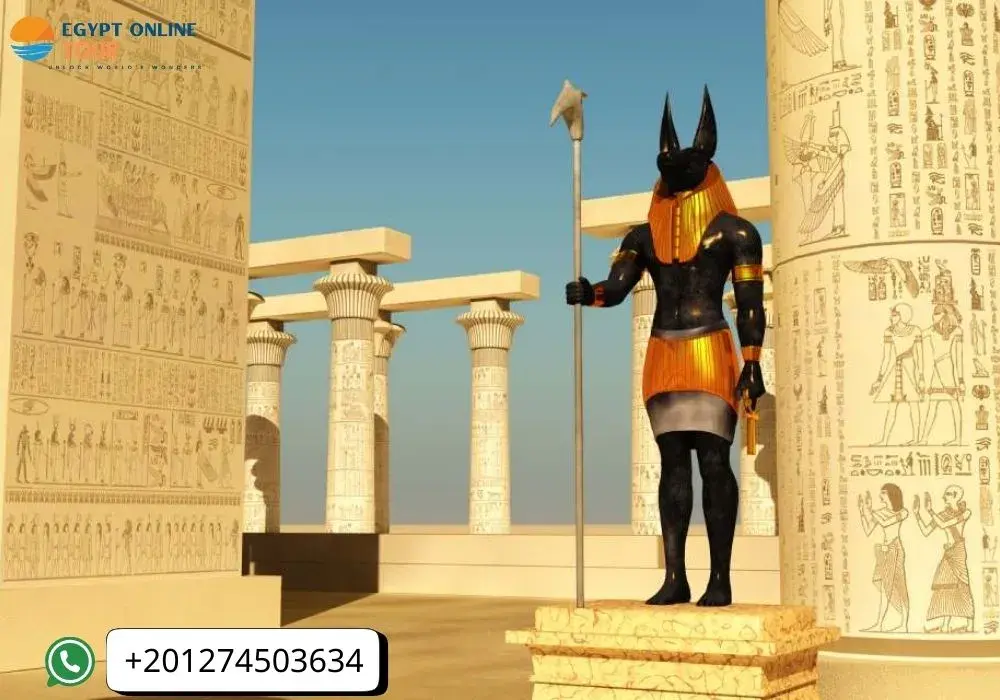
Key Features of the Hathor Chapel and Anubis Shrine
Element | Description | Significance |
Hathor Chapel | Chapel with sistrum-shaped columns. | Linked Hatshepsut with Hathor as her divine mother and source of legitimacy. |
Milk Ritual | Relief of Hathor nursing Hatshepsut. | Symbolized divine approval and her role as the chosen ruler of Egypt. |
Anubis Shrine | Shrine marked with jackal symbols of Anubis. | Connected the temple with protection, death rites, and the afterlife. |
Protective Reliefs | Scenes of Anubis blessing Hatshepsut. | Ensured eternal life, divine guardianship, and the queen’s safe journey beyond. |
Balance of Shrines | Hathor on the south, Anubis on the north. | Represented cosmic order—life, death, and harmony in Hatshepsut’s reign. |
The Mortuary temple of Hatshepsut was more than stone terraces and elegant ramps. Within its chapels, sacred scenes declared her divine right to rule. The Hathor Chapel tied her to fertility, motherhood, and joy, while the Anubis Shrine linked her reign with eternal protection. Together, these inner spaces told a story of balance. They joined life and death, love and judgment, earthly rule and divine order. Today, they remain vital stops for visitors who want to understand how art, faith, and politics shaped one of Egypt’s most remarkable queens.
Osiride Statues of Hatshepsut: Symbols of Eternal Power
The Mortuary Temple of Hatshepsut at Deir el-Bahari is one of Egypt’s greatest monuments. Yet within its terraces, the Osiride Statues of Hatshepsut stand out as lasting icons of divine rule. These statues were not only artistic masterpieces but also political declarations. Osiris, the god of resurrection and perpetual life, was associated with Hatshepsut.. Through them, the queen projected her authority, securing legitimacy in a world dominated by male rulers.
Key Features of the Osiride Statues of Hatshepsut
Sacred Location
- Positioned on the upper terrace of the temple.
- Flanked the colonnades and lined processional paths.
- Their placement emphasized holiness and divine authority.
Royal Appearance
- Depicted with the nemes headdress, false beard, and royal kilt.
- Arms crossed over the chest, holding crook and flail.
- Showed Hatshepsut in the same pose as Osiris.
Symbol of Transformation
- Osiride form linked her with resurrection and eternal kingship.
- Projected stability, continuity, and divine favor.
- reinforced her authority in a culture that was wary of female pharaohs.
Materials and Scale
- Crafted mainly from limestone and sandstone.
- Some were painted with vibrant colors to increase realism.
- Larger-than-life in scale, demanding attention and respect.
Connection with Rituals
- Statues witnessed processions during festivals of Amun.
- Her function as a go-between for the gods and humans was strengthened by their presence.
- The temple design ensured constant visibility during ceremonies.
Religious and Political Role
- Osiride statues symbolized Hatshepsut’s eternal bond with Osiris.
- They validated her as chosen by Amun and protected by Osiris.
- Her reign was presented as sacred, beyond human challenge.
- This imagery reduced opposition to her role as a female ruler.
- The statues made the Mortuary Temple of Hatshepsut both a religious and political statement.
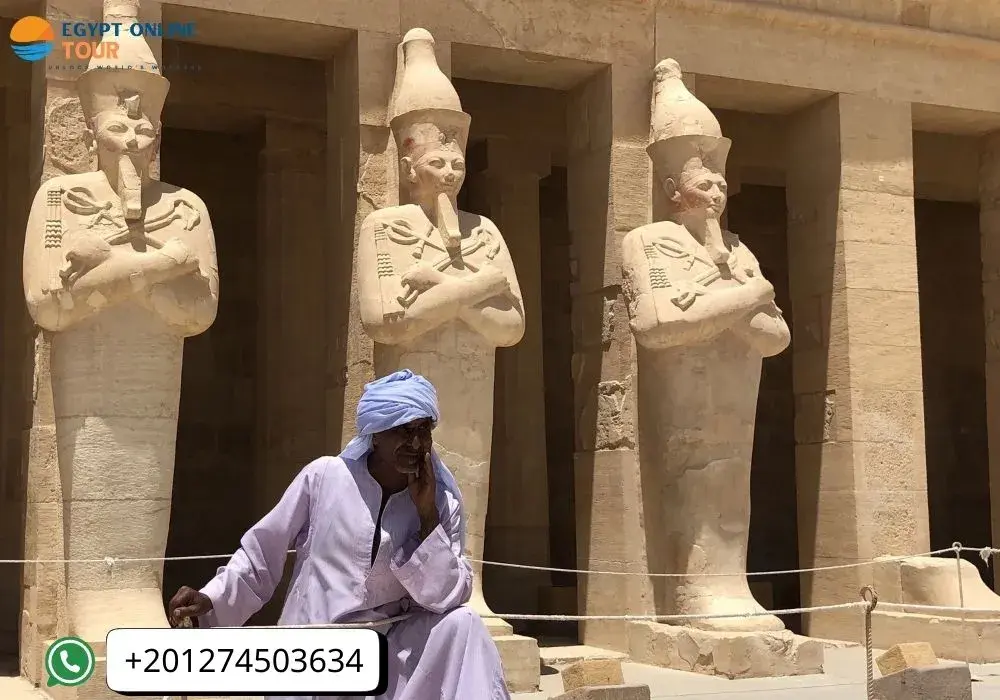
Key Details of the Osiride Statues
Feature | Description | Significance |
Pose | Arms crossed, crook and flail held. | Linked her directly to Osiris, the god of resurrection and eternal life. |
Appearance | Nemes crown, false beard, royal kilt. | Displayed authority, divine kingship, and the image of a male pharaoh. |
Location | Upper terrace, facing processional paths. | Reinforced her presence and power during temple rituals and ceremonies. |
Material | Limestone and sandstone, some once painted. | Reflected wealth, resources, and artistic attention to royal detail. |
Religious Role | Present at the ceremonies of Amun. | Blended politics, devotion, and divine legitimacy into temple worship. |
Symbolism | Eternal life, protection, divine authority. | Strengthened her claim as Egypt’s rightful pharaoh with sacred associations. |
The Mortuary temple of Hatshepsut was more than terraces and ramps—it was a stage for divine kingship. The Osiride Statues of Hatshepsut told a clear story: she was not only Egypt’s ruler but also a figure chosen and protected by the gods. Despite later attempts to erase her memory, these statues remain powerful symbols of resilience. Today, they continue to inspire visitors and historians, reminding us of her extraordinary vision and eternal legacy.
For a luxurious, comfortable, and unforgettable trip to Egypt, check out Egypt Luxury Tours
What Do 6 Key Facts Reveal About The Valley Temple and Causeway?
Yet the story begins before visitors reach its famous terraces. It starts with The Valley Temple and Causeway, the ceremonial gateway that led pilgrims, priests, and offerings from the Nile to the sanctuary. These structures were not just practical routes but spiritual passages that symbolized the transition from the earthly world to divine presence.
6 Key Facts About the Valley Temple and Causeway
Location of the Valley Temple
- Stood at the edge of the Nile floodplain.
- Functioned as the ceremonial entrance to the temple complex.
- Received goods and offerings brought by river transport.
Design of the Valley Temple
- Likely built with limestone and sandstone blocks.
- Contained halls, storage areas, and rooms for rituals.
- Acted as the first sacred station for processions.
The Causeway’s Role
- The terraces and the Valley Temple were joined by a lengthy stone-paved path.
- Decorated with reliefs showing rituals, festivals, and offerings.
- Guided visitors physically and spiritually toward the sanctuary.
Religious Symbolism
- The Valley Temple marked the transition from daily life to sacred ground.
- The causeway symbolized a journey toward the divine world.
- Each step reflected purification before reaching Amun’s sanctuary.
Connection to Festivals
- Processions during the Festival of the Valley passed through here.
- Priests carried statues of gods along the causeway to the temple.
- Celebrations reinforced the queen’s divine link to Amun.
Political Role for Hatshepsut
- Her assertion that she was the gods' chosen one was supported by the design.
- Visitors witnessed her divine legitimacy before reaching the main temple.
- Architecture turned religious belief into political authority.
Key Features of the Valley Temple and Causeway
Feature | Description | Significance |
Valley Temple | Entrance temple at the floodplain edge | Marked the ceremonial start of the temple complex. |
Material | Built with limestone and sandstone | Displayed wealth and access to quality resources. |
Causeway Path | Stone-paved, decorated passageway | Guided rituals and visitors toward the sanctuary. |
Reliefs | Scenes of offerings, rituals, and festivals | Taught religious values and praised the queen. |
Religious Role | Gateway from earthly life to sacred space | Marked the journey to divine presence. |
Political Role | Linked Hatshepsut with divine selection | Strengthened her legitimacy as a female ruler. |
The Mortuary Temple of Hatshepsut's journey began with the Valley Temple and Causeway, guiding visitors from the Nile to sacred rituals. The Valley Temple welcomed offerings, while the causeway linked life to divine presence. Even today, their remains reveal that Egyptian architecture blended faith, politics, and vision into enduring masterpieces of stone.
Let our local travel experts help you design the perfect itinerary. Whether you're seeking adventure, culture, or relaxation, we've got you covered!
Role of Senenmut in the Temple’s Construction
The Mortuary Temple of Hatshepsut at Deir el-Bahari is one of ancient Egypt’s greatest achievements. The mind behind the plan and build was Senenmut. As Hatshepsut’s chief aide, he turned the temple idea into stone. His work blended politics, religion, and engineering in ways still admired today. The Role of Senenmut in the Temple’s Construction highlights how a single architect could transform faith into stone and secure a queen’s legacy.
Senenmut: The Man Behind the Vision
- Senenmut rose from modest beginnings to high office under Hatshepsut.
- He became steward, tutor, and chief architect, roles rarely held together.
- His close bond with the queen gave him influence unmatched by others.
- He received over 20 titles, reflecting both trust and authority.
- Ancient inscriptions praise his skill and loyalty.
- In addition to designing temples, he oversaw other projects all around Egypt.
- His unique rise shows how talent could outweigh noble birth in ancient society.
Architectural Genius at Deir el-Bahari
- Architectural Genius at Deir el-Bahari
- Senenmut set Hatshepsut’s temple so it stood out against the cliffs of Deir el-Bahari.
- He designed terraces that echoed Mentuhotep II’s temple nearby, yet were far more advanced.
- Set in line with Karnak Temple, it formed a symbolic link across the Nile.
- Processional ramps joined the terraces, leading visitors through each sacred stage.
- By matching Karnak’s axis, the site forged a symbolic thread across the river.
- Ramps linked the terraces, moving guests through ordered stages of
- Reliefs and chapels celebrated gods while reinforcing Hatshepsut’s divine birth.
- His design made the temple both a shrine and a show of power
- The use of symmetry and balance showed innovation beyond his time.
Religious and Political Purpose
- Senenmut designed chapels for Hathor, Anubis, and Amun to honor major gods.
- To prove Hatshepsut's legitimacy, Senenmut created scenes of her celestial birth.
- The temple highlighted peaceful trade missions, not just military victories.
- Every element tied her rule to divine approval.
- Architecture became propaganda, securing her power in a male-dominated world.
- Senenmut ensured religion and politics worked together through design.
Engineering and Artistic Skill
- He managed hundreds of workers and artisans with precision.
- Imported materials like red granite and exotic woods were carefully used.
- Reliefs depicted scenes of trade, ritual, and divine blessing.
- Gardens with myrrh trees from Punt added life to stone.
- Osiride statues blended pharaoh imagery with gods, symbolizing eternity.
- Senenmut turned architecture into storytelling for both people and gods.
Controversy and Mystery
- Senenmut’s closeness to Hatshepsut sparked speculation in ancient times.
- His tombs at Thebes included imagery connecting him to the queen’s reign.
- His name was later removed from certain places after she passed away.
- This shows how political shifts could threaten even trusted officials.
- Despite erasure, his work at the Mortuary Temple of Hatshepsut secured his legacy.
Today, the Hatshepsut Mortuary Temple is more than just a set of stone terraces. His designs balanced religion, politics, and innovation. They told stories of divine birth, prosperity, and legitimacy in ways visitors could see and believe. Although his memory faced erasure, the temple itself preserved his work. The Role of Senenmut in the Temple’s Construction remains one of the clearest examples of how architecture served both gods and rulers in ancient Egypt.

Restoration and Archaeological Discoveries at the Mortuary Temple of Hatshepsut
Hatshepsut’s mortuary temple survived damage, defacement, and ages of neglect. Through restoration and discoveries, its story continues to grow. The following highlights reveal how archaeologists brought new life to this monument and uncovered secrets hidden for thousands of years.
Early Rediscovery and First Studies
- European travelers recorded the temple in the 18th century.
- Explorers mapped the site and noted ruined terraces.
- First serious excavations began in the 19th century.
- Auguste Mariette and Édouard Naville led major early digs.
- Reliefs were documented, but preservation was limited.
Restoration Efforts in the 20th Century
- By the 1900s, the temple faced collapse from centuries of neglect.
- The Metropolitan Museum of Art worked here under Herbert Winlock.
- Walls, ramps, and statues were rebuilt using original fragments.
- In 1961, the Polish Academy of Sciences launched major projects.
- Since then, restoration has stabilized terraces and chapels.
- Conservation teams continue to clean and protect painted reliefs.
Key Archaeological Discoveries
- Thousands of broken statue fragments were unearthed.
- Reliefs depicting the Punt Expedition have been restored and researched.
- Scenes of Hatshepsut’s divine birth revealed her claim to rule.
- Chapels of Hathor, Anubis, and Amun were cleared and rebuilt.
- Remains of ancient gardens, once planted with myrrh trees, were found.
- Inscriptions proved attempts to erase Hatshepsut by Thutmose III.
- Excavations revealed reused stones from earlier temples.
Modern Preservation and Technology
- Laser scanning now records fragile wall carvings.
- Digital mapping helps restore damaged reliefs.
- Teams use chemical treatments to protect sandstone.
- Climate monitoring prevents humidity from damaging painted surfaces.
- Visitor pathways were redesigned to protect vulnerable areas.
Why These Efforts Matter
- Restoration allows tourists to walk the same ramps as priests.
- Discoveries reveal Egypt’s trade, politics, and religion in detail.
- The site shows how power, faith, and art worked together.
- Preservation ensures the temple remains for future generations.
The Mortuary Temple of Hatshepsut is more than a structure carved into stone. It is a record of ambition, loss, and revival. Thanks to centuries of restoration and archaeological finds, the terraces now tell a full story. They show the devotion of a queen, the artistry of her time, and the strength of modern science in saving the past. Today, the temple is both a treasure of history and a living classroom for all who visit Luxor.
Best Time to Visit the Mortuary Temple of Hatshepsut
The best time to visit the Mortuary Temple of Hatshepsut is between October and April, when the climate is pleasant. Early mornings are ideal, since the light beautifully highlights the terraces and reliefs. Moreover, crowds are fewer, allowing a more peaceful experience. Summer remains extremely hot, yet visiting at sunrise can still be rewarding. Therefore, careful timing ensures you enjoy both the history and the dramatic views in comfort.
Read about: Best Months to Visit Egypt
How to Get to Deir el-Bahari from Luxor
Reaching Deir el-Bahari from Luxor is simple and quick. Travelers first cross the Nile to the West Bank, either by ferry or private boat. From there, taxis, minibuses, and guided tours are available, leading directly to the cliffs of the Mortuary Temple of Hatshepsut. Since afternoons can be very hot, visiting early morning ensures cooler weather, fewer crowds, and more time to explore the temple’s terraces and chapels comfortably.
Don't pass up Egypt Adventure Tours opportunity to see it.
Visitor Tips for Exploring the Temple
At Deir el-Bahari, Hatshepsut’s mortuary temple ranks as one of Luxor’s most notable sights. To enjoy it fully, planning matters. Because of the desert heat and the temple’s layout, visitors should follow practical tips that make the experience smoother and more memorable. Below are key recommendations to guide your trip and help you appreciate this masterpiece of ancient Egypt.
- Arrive early in the morning
The temple opens at sunrise. Visiting early avoids intense heat and large tour groups. - Wear light clothes and a hat
The terraces reflect sunlight strongly. Breathable fabrics, hats, and sunglasses are essential. - Carry enough water
The site has limited shade. Staying hydrated ensures you can walk comfortably. - Use sturdy footwear
Terraces and ramps require steady walking. Comfortable shoes are better than sandals. - Take time on each terrace
Each level has unique reliefs, statues, and chapels worth exploring carefully. - Visit with a guide
Guides explain religious meanings, trade scenes, and the role of Queen Hatshepsut. - Explore nearby sites
Visit it alongside the Valley of the Kings and nearby West Bank shrines. - Respect preservation rules
Avoid touching reliefs or statues. Photography is allowed but without flash. - Plan transport in advance
Taxis, buses, and tours from Luxor are widely available, but prices vary.
The Mortuary Temple of Hatshepsut is more than a monument; it’s a journey into Egypt’s golden age. By following these visitor tips, you can experience its history, art, and meaning in the best way possible.
We can't wait to meet you, so book your Egypt tour packages now and enjoy your amazing journey.
Summary
The Mortuary Temple of Hatshepsut remains one of the most remarkable monuments in ancient Egypt, reflecting art, faith, and royal authority. Its terraces, shrines, and reliefs highlight the reign of Egypt’s celebrated female pharaoh. Travelers can still follow the routes once used for rituals and ceremonies. With the support of Egypt Online Tour, visiting the Mortuary Temple of Hatshepsut becomes effortless, offering an authentic chance to connect with the legacy of Egypt’s golden past.
Frequently Asked Questions
1 Where is the Mortuary Temple of Hatshepsut located? ▶
2 Who built the Mortuary Temple of Hatshepsut? ▶
3 What are the Punt Expedition Reliefs? ▶
4 What do the Divine Birth Scenes depict? ▶
5 Why was Hatshepsut's legacy almost erased? ▶
Popular Categories
Popular Posts

Top Alexandria Beaches You Must Visit 2026

What are the important holidays in Egypt?

What countries have pyramids- Know the full details
Related tours
Cairo, Aswan, and Luxor
-
Price
$ 5,900
-
Type
Package
Cairo, Aswan, and Luxor
-
Price
$ 1,850
-
Type
Package
